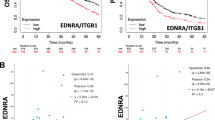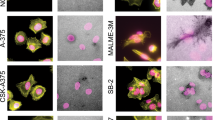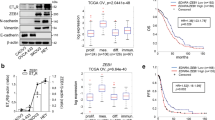Abstract
The endothelin-1 (ET-1)/ET A receptor (ETAR) signalling pathway is a well-established driver of epithelial ovarian cancer (EOC) progression. One key process promoted by ET-1 is tumor cell invasion, which requires the scaffolding functions of β-arrestin-1 (β-arr1) downstream of the receptor; however, the potential role of ET-1 in inducing invadopodia, which are crucial for cellular invasion and tumor metastasis, is completely unknown. We describe here that ET-1/ETAR, through β-arr1, activates RhoA and RhoC GTPase and downstream ROCK (Rho-associated coiled coil-forming kinase) kinase activity, promoting actin-based dynamic remodelling and enhanced cell invasion. This is accomplished by the direct interaction of β-arr1 with PDZ-RhoGEF (postsynaptic density protein 95/disc-large/zonula occludens-RhoGEF). Interestingly, ETAR-mediated invasive properties are related to the regulation of invadopodia, as evaluated by colocalization of actin with cortactin, as well as with TKS5 and MT1-MMP (membrane type 1-matrix metalloproteinase) with areas of matrix degradation, and activation of cofilin pathway, which is crucial for regulating invadopodia activity. Depletion of PDZ-RhoGEF, or β-arr1, or RhoC, as well as the treatment with the dual ET-1 receptor antagonist macitentan, significantly impairs invadopodia function, MMP activity and invasion, demonstrating that β-arr1/PDZ-RhoGEF interaction mediates ETAR-driven ROCK-LIMK-cofilin pathway through the control of RhoC activity. In vivo, macitentan is able to inhibit metastatic dissemination and cofilin phosphorylation. Collectively, our data unveil a noncanonical activation of the RhoC/ROCK pathway through the β-arr1/PDZ-RhoGEF complex as a regulator of ETAR-induced motility and metastasis, establishing ET-1 axis as a novel regulator of invadopodia protrusions through the RhoC/ROCK/LIMK/cofilin pathway during the initial steps of EOC invasion.
This is a preview of subscription content, access via your institution
Access options
Subscribe to this journal
Receive 50 print issues and online access
$259.00 per year
only $5.18 per issue
Buy this article
- Purchase on Springer Link
- Instant access to full article PDF
Prices may be subject to local taxes which are calculated during checkout








Similar content being viewed by others
References
Hall A . The cytoskeleton and cancer. Cancer Metast Rev 2009; 28: 5–14.
Sahai E, Marshall CJ . Rho-GTPases and cancer. Nat Rev Cancer 2002; 2: 133–142.
Spiering D, Hodgson L . Dynamics of the Rho-family small GTPases in actin regulation and motility. Cell Adhes Migr 2011; 2: 1–11.
Siehler S . Regulation of RhoGEF proteins by G12/13-coupled receptors. Br J Pharmacol 2009; 158: 41–49.
Fukuhara S, Chikumi H, Galisteo R, Mukouyama YS, Bugge TH, Gutkind JS . PDZ-RhoGEF and LARG are essential for embryonic development and provide a link between thrombin and LPA receptors and Rho activation. J Biol Chem 2013; 26: 12232–12243.
Aittaleb M, Gao G, Evelyn CR, Neubig RR, Tesmer JJ . A conserved hydrophobic surface of the LARG pleckstrin homology domain is critical for RhoA activation in cells. Cell Signal 2009; 21: 1569–1578.
Zheng R, Iwase A, Shen R, Goodman OB Jr, Sugimoto N, Takuwa Y et al. Neuropeptide-stimulated cell migration in prostate cancer cells is mediated by RhoA kinase signaling and inhibited by neutral endopeptidase. Oncogene 2006; 25: 5942–5952.
Murphy DA, Courtneidge SA . The ‘ins’ and ‘outs’ of podosomes and invadopodia: characteristics, formation and function. Nat Rev Mol Cell Biol 2011; 12: 413–426.
Saykali BA, El-Sibai M . Invadopodia, regulation, and assembly in cancer cell invasion. Cell Commun Adhes 2014; 21: 207–212.
Ward JD, Ha JH, Jayaraman M, Dhanasekaran DN . LPA-mediated migration of ovarian cancer cells involves translocalization of Gαi2 to invadopodia and association with Src and β-pix. Cancer Lett 2015; 356: 382–391.
Ridley AJ . RhoA, RhoB and RhoC have different roles in cancer cell migration. J Microsc 2013; 251: 242–249.
Bravo-Cordero JJ, Oser M, Chen X, Eddy R, Hodgson L, Condeelis J . A novel spatiotemporal RhoC activation pathway locally regulates cofilin activity at invadopodia. Curr Biol 2011; 21: 635–644.
Gligorijevic B, Wyckoff J, Yamaguchi H, Wang Y, Roussos ET, Condeelis J . N-WASP-mediated invadopodium formation is involved in intravasation and lung metastasis of mammary tumors. J Cell Sci 2012; 125: 724–734.
Eckert MA, Lwin TM, Chang AT, Kim J, Danis E, Ohno-Machado L et al. Twist1-induced invadopodia formation promotes tumor metastasis. Cancer Cell 2011; 19: 372–386.
Moshfegh Y, Bravo-Cordero JJ, Miskolci V, Condeelis J, Hodgson L . A Trio-Rac1-Pak1 signalling axis drives invadopodia disassembly. Nat Cell Biol 2014; 16: 574–586.
Roh-Johnson M, Bravo-Cordero JJ, Patsialou A, Sharma VP, Guo P, Liu H et al. Macrophage contact induces RhoA GTPase signaling to trigger tumor cell intravasation. Oncogene 2014; 33: 4203–4212.
Pichot CS, Arvanitis C, Hartig SM, Jensen SA, Bechill J, Marzouk S et al. Cdc42-interacting protein 4 promotes breast cancer cell invasion and formation of invadopodia through activation of N-WASp. Cancer Res 2010; 70: 8347–8356.
Rosanò L, Spinella F, Bagnato A . Endothelin 1 in cancer: biological implications and therapeutic opportunities. Nat Rev Cancer 2013; 13: 637–651.
Shukla AK, Xiao K, Lefkowitz RJ . Emerging paradigms of β-arrestin-dependent seven transmembrane receptor signaling. Trends Biochem Sci 2011; 36: 457–469.
Min J, Defea K . β-Arrestin-dependent actin reorganization: bringing the right players together at the leading edge. Mol Pharmacol 2011; 80: 760–768.
DeFea KA . Arrestins in actin reorganization and cell migration. Prog Mol Biol Transl Sci 2013; 118: 205–222.
Rosanò L, Cianfrocca R, Masi S, Spinella F, Di Castro V, Biroccio A et al. Beta-arrestin links endothelin A receptor to beta-catenin signaling to induce ovarian cancer cell invasion and metastasis. Proc Natl Acad Sci USA 2009; 24: 2806–2811.
Rosanò L, Cianfrocca R, Tocci P, Spinella F, Di Castro V, Spadaro F et al. β-Arrestin-1 is a nuclear transcriptional regulator of endothelin-1-induced β-catenin signaling. Oncogene 2013; 32: 5066–5077.
Spinella F, Caprara V, Di Castro V, Rosanò L, Cianfrocca R, Natali PG et al. Endothelin-1 induces the transactivation of vascular endothelial growth factor receptor-3 and modulates cell migration and vasculogenic mimicry in melanoma cells. J Mol Med 2013; 91: 395–405.
Rosanò L, Varmi M, Salani D, Di Castro V, Spinella F, Natali PG et al. Endothelin-1 induces tumor proteinase activation and invasiveness of ovarian carcinoma cells. Cancer Res 2001; 61: 8340–8346.
Rosanò L, Spinella F, Di Castro V, Nicotra MR, Dedhar S, de Herreros AG et al. Endothelin-1 promotes epithelial-to-mesenchymal transition in human ovarian cancer cells. Cancer Res 2005; 65: 11649–11657.
Rosanò L, Cianfrocca R, Tocci P, Spinella F, Di Castro V, Caprara V et al. Endothelin A receptor/β-arrestin signaling to the Wnt pathway renders ovarian cancer cells resistant to chemotherapy. Cancer Res 2014; 74: 7453–7464.
Horiuchi A, Imai T, Wang C, Ohira S, Feng Y, Nikaido T et al. Up-regulation of small GTPases, RhoA and RhoC, is associated with tumor progression in ovarian carcinoma. Lab Invest 2003; 83: 861–870.
Zhao Y, Zong ZH, Xu HM . RhoC expression level is correlated with the clinicopathological characteristics of ovarian cancer and the expression levels of ROCK-I, VEGF, and MMP9. Gynecol Oncol 2010; 116: 563–571.
Korkina O, Dong Z, Marullo A, Warshaw G, Symons M, Ruggieri R . The MLK-related kinase (MRK) is a novel RhoC effector that mediates lysophosphatidic acid (LPA)-stimulated tumor cell invasion. J Biol Chem 2013; 288: 5364–5373.
Zhao Y, Zheng HC, Chen S, Gou WF, Xiao LJ, Niu ZF . The role of RhoC in ovarian epithelial carcinoma: a marker for carcinogenesis, progression, prognosis, and target therapy. Gynecol Oncol 2013; 130: 570–578.
Gou WF, Zhao Y, Lu H, Yang XF, Xiu YL, Zhao S et al. The role of RhoC in epithelial-to-mesenchymal transition of ovarian carcinoma cells. BMC Cancer 2014; 14: 477.
Chen S, Wang J, Gou WF, Xiu YL, Zheng HC, Zong ZH et al. The involvement of RhoA and Wnt-5a in the tumorigenesis and progression of ovarian epithelial carcinoma. Int J Mol Sci 2013; 14: 24187–24199.
Cook DR, Rossman KL, Der CJ . Rho guanine nucleotide exchange factors: regulators of Rho GTPase activity in development and disease. Oncogene 2014; 33: 4021–4035.
Anthony DF, Sin YY, Vadrevu S, Advant N, Day JP, Byrne AM et al. β-Arrestin 1 inhibits the GTPase-activating protein function of ARHGAP21, promoting activation of RhoA following angiotensin II type 1A receptor stimulation. Mol Cell Biol 2011; 31: 1066–1075.
Ma X, Zhao Y, Daaka Y, Nie Z . Acute activation of β2-adrenergic receptor regulates focal adhesions through βArrestin2- and p115RhoGEF protein-mediated activation of RhoA. J Biol Chem 2012; 287: 18925–18936.
Mythreye K, Blobe GC . The type III TGF-beta receptor regulates epithelial and cancer cell migration through beta-arrestin2-mediated activation of Cdc42. Proc Natl Acad Sci USA 2009; 106: 8221–8226.
Bhattacharya M, Anborgh PH, Babwah AV, Dale LB, Dobransky T, Benovic JL et al. Beta-arrestins regulate a Ral-GDS Ral effector pathway that mediates cytoskeletal reorganization. Nat Cell Biol 2002; 4: 547–555.
Bravo-Cordero JJ, Magalhaes MA, Eddy RJ, Hodgson L, Condeelis J . Functions of cofilin in cell locomotion and invasion. Nat Rev Mol Cell Biol 2013; 14: 405–415.
Yamaguchi H, Lorenz M, Kempiak S, Sarmiento C, Coniglio S, Symons M et al. Molecular mechanisms of invadopodium formation: the role of the N-WASP-Arp2/3 complex pathway and cofilin. J Cell Biol 2005; 168: 441–452.
Rosanò L, Cianfrocca R, Spinella F, Di Castro V, Nicotra MR, Lucidi A et al. Acquisition of chemoresistance and EMT phenotype is linked with activation of the endothelin A receptor pathway in ovarian carcinoma cells. Clin Cancer Res 2011; 17: 2350–2360.
Ogata S, Morishige K, Sawada K, Hashimoto K, Mabuchi S, Kawase C et al. Fasudil inhibits lysophosphatidic acid-induced invasiveness of human ovarian cancer cells. Int J Gynecol Cancer 2009; 19: 1473–1480.
Cleghorn WM, Branch KM, Kook S, Arnette C, Bulus N et al. Arrestins regulate cell spreading and motility via focal adhesion dynamics. Mol Biol Cell 2015; 26: 622–635.
Shankar H, Michal A, Kern RC, Kang DS, Gurevich VV et al. Non-visual arrestins are constitutively associated with the centrosome and regulate centrosome function. J Biol Chem 2010; 285: 8316–8329.
Ma X, Espana-Serrano L, Kim WJ, Thayele Purayil H, Nie Z, Daaka Y . β-Arrestin1 regulates the guanine nucleotide exchange factor RasGRF2 expression and the small GTPase Rac-mediated formation of membrane protrusion and cell motility. J Biol Chem 2014; 289: 13638–13650.
Mittal N, Roberts K, Pal K, Bentolila LA, Fultz E, Minasyan A et al. Select G-protein-coupled receptors modulate agonist-induced signaling via a ROCK, LIMK, and β-arrestin 1 pathway. Cell Rep 2013; 5: 1010–1021.
Zoudilova M, Min J, Richards HL, Carter D, Huang T, DeFea KA . beta-Arrestins scaffold cofilin with chronophin to direct localized actin filament severing and membrane protrusions downstream of protease-activated receptor-2. J Biol Chem 2010; 285: 14318–14329.
Xiao K, McClatchy DB, Shukla AK, Zhao Y, Chen M, Shenoy SK et al. Functional specialization of beta-arrestin interactions revealed by proteomic analysis. Proc Natl Acad Sci USA 2007; 104: 12011–12016.
Struckhoff AP, Rana MK, Kher SS, Burow ME, Hagan JL, Del Valle L et al. PDZ-RhoGEF is essential for CXCR4-driven breast tumor cell motility through spatial regulation of RhoA. J Cell Sci 2013; 126: 4514–4526.
Patel M, Kawano T, Suzuki N, Hamakubo T, Karginov AV, Kozasa T . Gα13/PDZ-RhoGEF/RhoA signaling is essential for gastrin-releasing peptide receptor-mediated colon cancer cell migration. Mol Pharmacol 2014; 86: 252–262.
Dunn HA, Ferguson SS . PDZ protein regulation of GPCR trafficking and signaling pathways. Mol Pharmacol 2015; 88: 624–639.
Martín-Villar E, Borda-d'Agua B, Carrasco-Ramirez P, Renart J, Parsons M, Quintanilla M et al. Podoplanin mediates ECM degradation by squamous carcinoma cells through control of invadopodia stability. Oncogene 2014; 34: 4531–4544.
Jaiswal M, Gremer L, Dvorsky R, Haeusler LC, Cirstea IC, Uhlenbrock K et al. Mechanistic insights into specificity, activity, and regulatory elements of the regulator of G-protein signaling (RGS)-containing Rho-specific guanine nucleotide exchange factors (GEFs) p115, PDZ-RhoGEF (PRG), and leukemia-associated RhoGEF (LARG). J Biol Chem 2011; 286: 18202–18212.
Chikumi H, Barac A, Behbahani B, Gao Y, Teramoto H, Zheng Y et al. Homo- and hetero-oligomerization of PDZ-RhoGEF, LARG and p115RhoGEF by their C-terminal region regulates their in vivo Rho GEF activity and transforming potential. Oncogene 2004; 23: 233–240.
Coffman L, Mooney C, Lim J, Bai S, Silva I, Gong Y et al. Endothelin receptor-A is required for the recruitment of antitumor T cells and modulates chemotherapy induction of cancer stem cells. Cancer Biol Ther 2013; 14: 184–192.
Kim SJ, Kim JS, Kim SW, Yun SJ, He J, Brantley E et al. Antivascular therapy for multidrug-resistant ovarian tumors by macitentan, a dual endothelin receptor antagonist. Transl Oncol 2012; 5: 39–47.
Kim SJ, Kim JS, Kim SW, Brantley E, Yun SJ, He J et al. Macitentan (ACT-064992), a tissue-targeting endothelin receptor antagonist, enhances therapeutic efficacy of paclitaxel by modulating survival pathways in orthotopic models of metastatic human ovarian cancer. Neoplasia 2011; 13: 167–179.
Kim SJ, Lee HJ, Kim SW, Choi HJ, He J, Wu Q et al. Macitentan, a dual endothelin receptor antagonist, in combination with temozolomide leads to glioblastoma regression and long-term survival in mice. Clin Cancer Res 2015, e-pub ahead of print 23 June 2015 doi:10.1158/1078-0432.CCR-14-3195.
Acknowledgements
We gratefully acknowledge Aldo Lupo for excellent technical assistance, Maria Vincenza Sarcone for secretarial assistance. This work was supported by Associazione Italiana Ricerca sul Cancro (AIRC) to AB (AIRC 14199) and LR (AIRC 12852). PT is recipient of Fondazione Italiana Ricerca sul Cancro (FIRC) fellowship.
Author information
Authors and Affiliations
Corresponding authors
Ethics declarations
Competing interests
The authors declare no conflict of interest.
Additional information
Supplementary Information accompanies this paper on the Oncogene website
Rights and permissions
About this article
Cite this article
Semprucci, E., Tocci, P., Cianfrocca, R. et al. Endothelin A receptor drives invadopodia function and cell motility through the β-arrestin/PDZ-RhoGEF pathway in ovarian carcinoma. Oncogene 35, 3432–3442 (2016). https://doi.org/10.1038/onc.2015.403
Received:
Revised:
Accepted:
Published:
Issue Date:
DOI: https://doi.org/10.1038/onc.2015.403
This article is cited by
-
The interaction of β-arrestin1 with talin1 driven by endothelin A receptor as a feature of α5β1 integrin activation in high-grade serous ovarian cancer
Cell Death & Disease (2023)
-
Comprehensive analysis of the prognostic implications and functional exploration of PAK gene family in human cancer
Cancer Cell International (2022)
-
Role of RhoC in cancer cell migration
Cancer Cell International (2021)
-
The role of MMP-14 in ovarian cancer: a systematic review
Journal of Ovarian Research (2021)
-
YAP and endothelin-1 signaling: an emerging alliance in cancer
Journal of Experimental & Clinical Cancer Research (2021)



